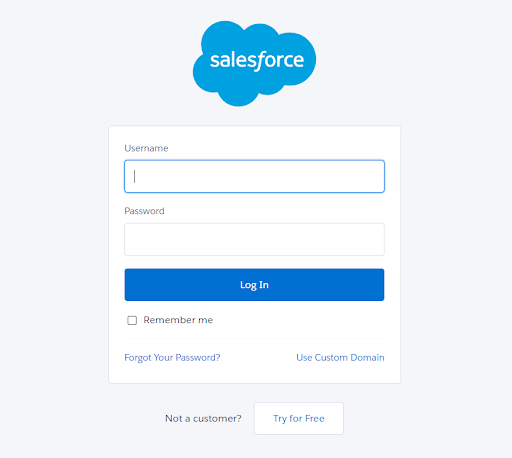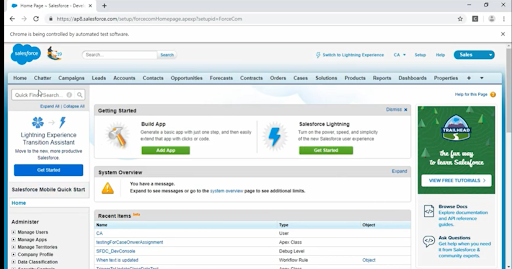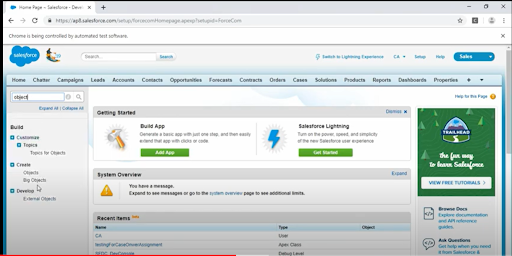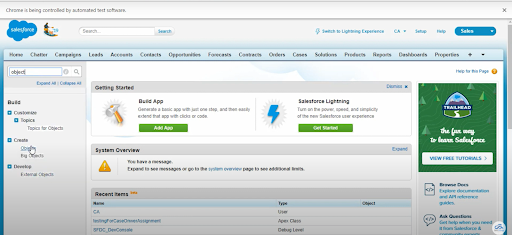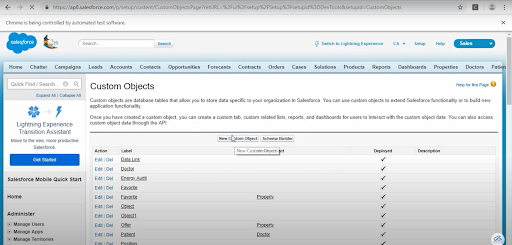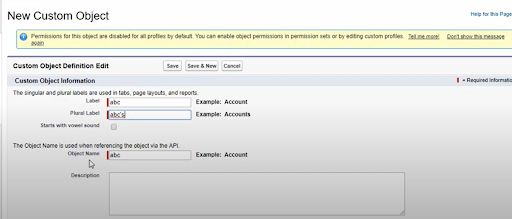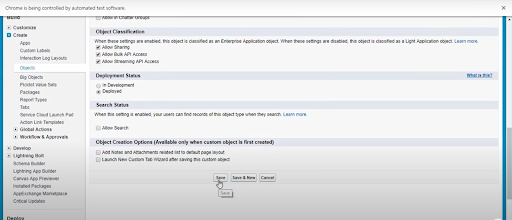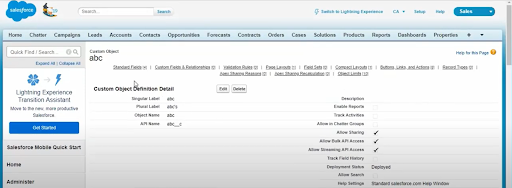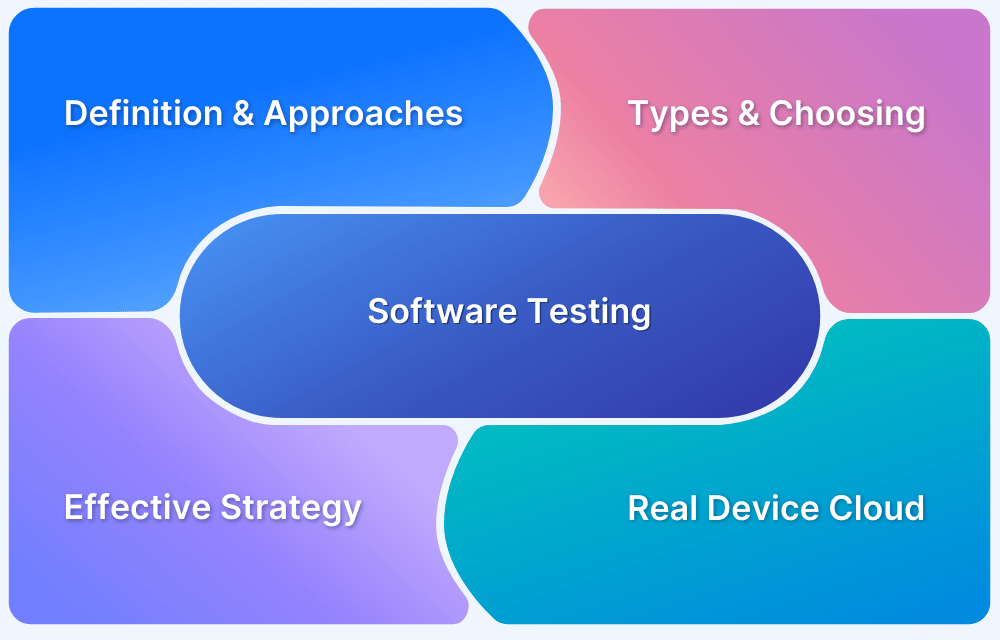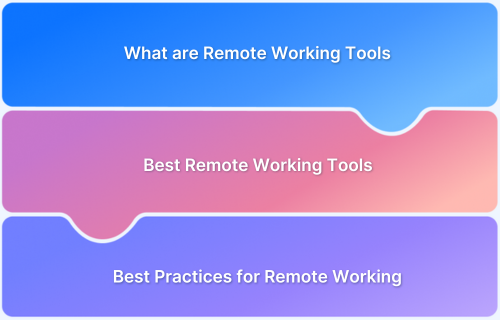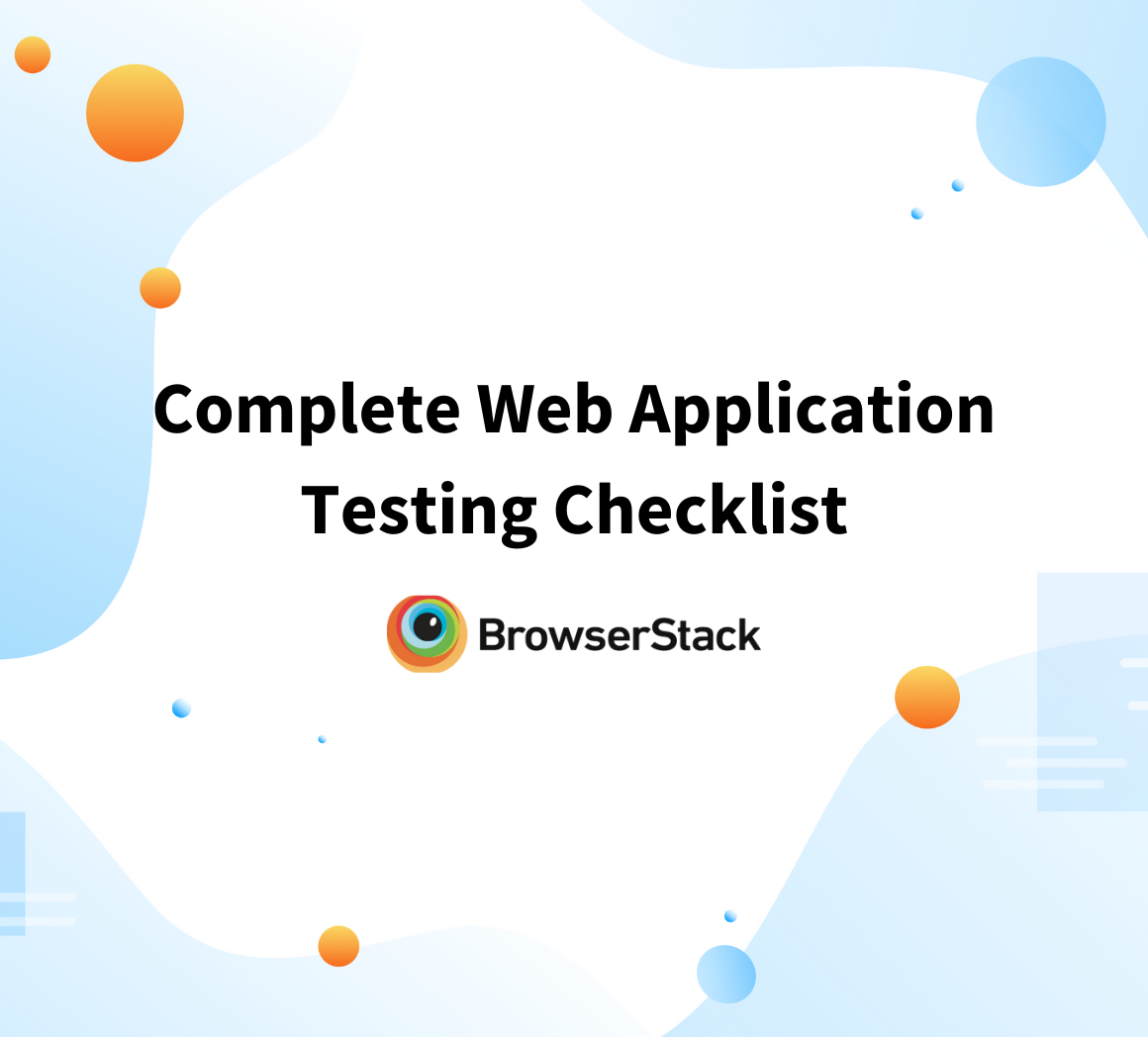Thorough Salesforce testing ensures every customization and integration works flawlessly, helping businesses deliver seamless customer experiences and maintain reliability at scale.
Overview
What is Salesforce Testing?
Salesforce testing is the process of verifying the functionality, performance, and reliability of Salesforce applications and customizations to ensure they meet business requirements and deliver a seamless user experience.
Importance of Salesforce Testing
- Validate Custom Code: Confirms that newly added functionality works as intended.
- Ensure Business Alignment: Verifies the app meets client-specific requirements.
- Catch Issues Early: Identifies bugs early in development, reducing cost and effort.
- Track Functional Accuracy: Uses test flows and case statuses to ensure system integrity.
Key aspects of Salesforce testing:
- Validation of Business Workflows: Ensures end-to-end business processes function as intended across modules.
- UI and Functional Testing: Verifies the dynamic Salesforce UI, Lightning components, and custom functionalities.
- Regression Testing: Detects defects introduced by frequent Salesforce updates or new configurations.
- Role-Based Access Testing: Confirms correct permissions, data visibility, and behavior for different user profiles.
- Integration Testing: Validates seamless data flow between Salesforce and third-party systems.
- Data Integrity Testing: Ensures accuracy, consistency, and security of data across objects and records.
- Cross-Browser and Cross-Device Testing: Guarantees consistent performance across multiple browsers and devices.
- Automation Testing: Increases test coverage, speeds up releases, and reduces manual effort using tools like BrowserStack Salesforce Test Automation.
This guide explains in everything about Salesforce Testing, its significance, types, levels, terminologies, challenges and solutions to overcome them.
What is Salesforce?
Salesforce is a leading cloud-based CRM platform that helps businesses manage sales, marketing, customer service, and other key operations from a single, unified system. It allows organizations to store customer data, automate workflows, track sales, and analyze customer interactions for better decision-making.
By streamlining customer relationship management, Salesforce boosts sales efficiency, enhances service quality, and supports business growth. In FY2024, it reported a record $34 billion in revenue, reflecting its dominance and widespread adoption across industries.
Common Salesforce Terminology
Understanding Salesforce terminology is crucial for effective Salesforce testing. Here are some key terms you need to know:
- Objects: Salesforce organizes data into objects, which are similar to tables in a database. Objects can be Standard (for example, Accounts, Contacts) or Custom (created by users to meet specific business needs).
- Fields: Fields are individual pieces of data stored within an object, comparable to columns in a table. Fields can be Standard or Custom, depending on the object they belong to.
- Records: Records are rows of data in an object. Each record represents a specific instance of an object, like a single account or contact.
- Page Layouts: These define the organization and visibility of fields, sections, and buttons on a Salesforce record’s user interface.
- Workflows and Process Builder: Automation tools that define business rules and actions, like sending notifications or updating records when specific criteria are met.
- Validation Rules: Rules that enforce data integrity by ensuring that the data entered in Salesforce meets specified conditions before saving.
- Apex: Salesforce’s proprietary programming language is used to execute complex logic and build custom features.
- Lightning Components: Modular, reusable components used in Salesforce’s modern user interface, Lightning Experience.
- Sandbox: A testing environment in Salesforce used to test changes without affecting the live production environment.
- SOQL (Salesforce Object Query Language): A query language similar to SQL used to retrieve data from Salesforce objects.
- Chatter: Salesforce’s built-in collaboration tool allows teams to discuss and share information within the platform.
- AppExchange: Salesforce’s marketplace for third-party apps and integrations that enhance Salesforce’s capabilities.
Read More: Salesforce Test Automation (Tools Included)
What is Salesforce Testing?
Salesforce testing refers to the process of evaluating and validating the functionality, quality, and performance of Salesforce applications and customizations. It involves conducting various tests to ensure that the Salesforce implementation meets the desired requirements, functions correctly, and delivers a positive user experience. Salesforce testing covers different aspects of the platform, including configuration, customization, integration, and data management.
BrowserStack Salesforce Test Automation is a cloud-powered, AI-driven platform that enables effortless automation testing for Salesforce apps on real browsers and devices. It uses artificial intelligence to simplify test designing, execution, and troubleshooting, ensuring consistent performance across diverse environments.
Why test Salesforce Applications?
Salesforce testing validates custom features built on top of the core Salesforce platform (SFDC). Since Salesforce is highly customizable, it’s crucial to ensure that these enhancements function correctly and don’t interfere with existing workflows.
Key Reasons to Test Salesforce Applications:
- Validate Custom Code: Confirms that newly added functionality works as intended.
- Ensure Business Alignment: Verifies the app meets client-specific requirements.
- Catch Issues Early: Identifies bugs early in development, reducing cost and effort.
Track Functional Accuracy: Uses test flows and case statuses to ensure system integrity.
Salesforce evolved from the Classic (Aloha) interface to the modern Lightning platform, offering enhanced UI, better security, and advanced functionality. This article focuses on testing within the Salesforce Lightning environment.
Roles and Responsibilities of a Salesforce Tester
Salesforce testers ensure that customized features work seamlessly within the Salesforce environment. Their responsibilities go beyond basic testing and require a deep understanding of the platform and business workflows.
Here are the core responsibilities of a Salesforce tester:
- Design both positive and negative test flows.
- Apply testing techniques like boundary value analysis and equivalence partitioning.
- Conduct smoke tests to validate critical functionalities.
- Understand Salesforce’s architecture, especially customizations and limitations.
- Validate Apex code and ensure integration compatibility.
- Build role-based test cases aligned with real user behavior.
- Coordinate closely with developers to test custom features and bug fixes.
- Ensure the customized application’s end-to-end functional accuracy.
Types of Salesforce Testing
Common types of testing performed in Salesforce include:
1. Native Salesforce Testing: Testing features provided by Salesforce out-of-the-box, such as standard objects, workflows, and validations. It ensures core functionalities meet business needs without external tools.
2. Manual Salesforce Testing: Testing Salesforce applications manually by executing predefined test cases. Ideal for UI testing, functional validations, and scenarios requiring human judgment.
3. Exploratory Salesforce Testing: An unscripted testing method to explore the application and identify hidden bugs. Perfect for discovering edge cases and usability issues in new or dynamic features.
4. Automated Salesforce Testing: Using tools like Selenium or Provar to automate repetitive tests such as regression or performance testing. It saves time and ensures consistent results for large applications.
Levels of Testing in Salesforce
Common types of testing performed in Salesforce include:
- Functional Testing: Functional testing focuses on verifying that the Salesforce application functions as intended. It involves testing various features and functionalities such as data entry, data manipulation, workflow automation, validation rules, and business logic.
- Unit Testing: Unit testing is conducted at the individual component level, such as triggers, classes, or Visualforce pages. It ensures that each unit of code behaves correctly and produces the expected results. Salesforce provides its own unit testing framework called Apex Testing, which allows developers to write and execute test methods for Apex code. Example: A developer has scripted a password input text field with its validation ar (8 characters long, must contain special characters.); makes a unit test to test out this one specific text field (has a test that only inputs 7 characters, no special characters, empty field)
- Integration Testing: Integration testing is performed to validate the interaction between Salesforce and external systems or applications. It ensures that data synchronization, API integrations, and other system interactions work correctly and produce the desired outcomes. Example: A tester writes a test case to ensure that the password is accurately saved in the database after generating one. This ensures that the code written by the developer is integrated with the system’s database.
- User Interface (UI) Testing: UI testing focuses on evaluating the user interface components of Salesforce applications, including layouts, forms, buttons, and navigation. It ensures that the UI elements are correctly displayed, responsive, and provide a seamless user experience.
- Performance Testing: Performance testing assesses the responsiveness, scalability, and stability of the Salesforce application under different loads and conditions. It helps identify any performance bottlenecks, such as slow response times, excessive resource consumption, or limitations in handling concurrent users.
- Security Testing: Security testing is crucial to ensure that sensitive data in Salesforce is adequately protected. It involves testing the application for vulnerabilities, access controls, data encryption, and compliance with security best practices.
- Data Management Testing: Data management testing focuses on validating data integrity, data migration, data transformation, and data import/export processes within Salesforce. It ensures that data is accurately stored, retrieved, and processed as required.
- Regression Testing: Regression testing involves retesting the previously tested functionalities after any changes or enhancements to ensure that existing features are not adversely affected. It helps ensure that new updates or modifications do not introduce unexpected issues or break existing functionality. Example: Checking for the login functionality after a new UI has been designed for the login page. Of these many types of testing, the Selenium Unit tests need to be written in the APEX programming language used by Salesforce, whereas the others can be done either manually or using an automation test tool like Selenium.
- User Acceptance Testing: Acceptance testing determines if a software system meets all predetermined specifications. It evaluates if the system complies with business, technical, and aesthetic requirements so that business stakeholders and end-users can be satisfied alike. Acceptance tests are generally divided into User Acceptance Testing and Business Acceptance Testing.The former checks to ensure that the product is meeting all performance standards from the users’ perspective while the latter establishes that the software aligns with business goals and requirements. Example: The client tests a particular functionality, like adding a customer to the CRM on a custom module on-site
Salesforce testing can be performed manually or using automated testing tools and frameworks. Automated testing helps improve efficiency, accuracy, and repeatability of tests, especially for large and complex Salesforce implementations.
Effective testing in Salesforce helps ensure the quality, reliability, and performance of the application, leading to enhanced user satisfaction and successful utilization of Salesforce capabilities in the business environment.
How to perform Salesforce Unit Testing in APEX
The @isTest is used to define classes and methods that only contain code used for testing the application.
A sample format would be
@isTest
private class MyTestClass {
@isTest static void test1() {
// Implement test code
}
@isTest static void test2() {
// Implement test code
}
}Below are a few examples of implementing Unit tests for some common Salesforce constructs:
For Triggers
A trigger is an APEX script that executes prior to or posts a Data Manipulation Event (DML). These allow the performance of custom actions before or after a record has undergone insertion, update, or deletion.
@isTest
public class TriggerTestClass
{
static testMethod void testMethod1()
{
// Perform DML here only
}
}For Standard Controllers
A standard controller takes a record and places it in a variable that it makes available to a page.
@isTest
public class ExtensionTestClass
{
static testMethod void testMethod1()
{
Account testAccount = new Account();
testAccount.Name='Test Account record' ;
insert testAccount;
Test.StartTest();
ApexPages.StandardController sc = new ApexPages.StandardController(testAccount);
myControllerExtension testAccPlan = new myControllerExtension(sc);
PageReference pageRef = Page.AccountPlan; // Add your VF page Name here
pageRef.getParameters().put('id', String.valueOf(testAccount.Id));
Test.setCurrentPage(pageRef);
//testAccPlan.save(); call all your function here
Test.StopTest();
}
}Some best practices for Unit testing in Salesforce include:
- Test class should be annotated with @isTest.
- Classes with @isTest annotation can’t be an interface or enum.
- Test method should be static and no void return type.
- Starting with the Salesforce API 28.0 test method can not reside inside non-test classes.
- To deploy to production at least 75% code coverage is required
Read More: Best Practices for Unit Testing
How to perform Manual and Automation Testing on Salesforce
Once the developers are happy with the test coverage through Unit Tests in Salesforce, it is time to perform a variety of manual or automation tests. However, before we start testing the SF applications, we must ensure to set up a Sandbox that allows us to perform these tests in isolation.
Salesforce Sandbox testing can be done on a variety of Sandbox types like:
- Developer Sandbox: This is intended for development and testing in an isolated environment. This contains a copy of the production environment’s configuration.
- Developer Pro Sandbox: This can host larger sets of data than the vanilla Developer Sandbox and has the capacity for increased development and quality assurance tasks and for integration testing or user training.
- Full Sandbox: This is meant as a dedicated testing environment, and supports performance testing, load testing, and staging. They are intended as a replica of the production org, including all data, such as object records and attachments and metadata. However, the significant lag due to the refresh interval makes them unsuitable for development purposes.
Read More: What is Browser Sandboxing
A Variety of licenses can be purchased for these Sandbox types as per your requirement.
Pro Tip: No emulator or simulator can replicate real user conditions. Software needs to be tested on real devices to work in real-world circumstances such as a low battery, incoming calls, weak network strength, and so on. If an in-house lab is not accessible, opt for a real device cloud.
Steps to Perform Manual Tests in Salesforce
Manual testing, as the term suggests, refers to a test process in which a QA manually tests the software application in order to identify bugs. To do so, QAs follow a written test plan that describes a set of unique test scenarios. The QA is required to analyze the performance of the web or mobile application from an end user’s perspective.
For the purposes of this article, take a simple positive test scenario of a successful login to the Salesforce site and write a brief test case accordingly.
Read More: Manual Testing for Beginners
Test Scenario: To authenticate a successful user login on Salesforce.com
Test Steps:
1. The user navigates to the Salesforce login page.
2. In the ’email’ field, the user enters their registered email address.
3. The user enters the registered password.
4. The user clicks ‘Login.’
5. The user is redirected to the Home page
Test Salesforce Manually on Real Device Cloud
Steps to Perform Automated Tests in Salesforce using Selenium
Selenium Salesforce Automation Tests can help automate functional testing in Salesforce, checking the user flows functionality. Salesforce Automation Testing with Selenium is largely recommended because:
- It is compatible with multiple operating systems like Windows, Linux, Solaris, and Macintosh.
- It also supports multiple browsers like Chrome, Safari, IE, Edge, and Firefox.
- Also, Selenium is easy to integrate with tools like Jenkins, Maven, and Docker to achieve a continuous testing approach.
- Tools like TestNG and JUnit further help in structuring the Selenium tests for easy maintainability and generating reports.
Read More: How to create Selenium test cases
For the purposes of this test, we shall build upon the example for manual testing shown above and add a few features. This Selenium Salesforce test will demonstrate how to create a custom field for a custom object using Selenium with Java.
Step 1: Login to the Salesforce
To launch the website in a browser of your choosing, set the system properties to the path of the required driver for the browser. Since this example uses Google Chrome, it should be set to the ChromeDriver. The code for the same is as follows.
Webdriver driver = new ChromeDriver();
System.setProperty("webdriver.chrome.driver", "Path of the chrome driver");Maximize the browser for a clear picture of test cases being executed using the following command.
driver.manage.window.maximize();
Step 2: Navigate to salesforce.com
driver.get("https://login.salesforce.com");It will appear as seen below
Step 3: Enter Username and Password using the following command
driver.findElement(By.xpath("//input[@id=’username’]”)).sendKeys(“<Enter email>”);
driver.findElement(By.xpath("//input[@id=password]”)).sendKeys(“<Enter Password>”);Step 4: Click the Login Button using the following command
driver.findElement(By.xpath("//input[@class=’button r4 wide primary’]”)).click();Since you may encounter some issues while loading the page, add a wait to let the page load completely
driver.manage().timeouts().implicitlyWait(10, TimeUnit.SECONDS);
This will lead to the Home Page as seen below
Step 5: Find the Quick Find Search Field in the UI on the home screen and enter object in the Quick Find Search field.
driver.findElement(By.xpath("//input[@class=’quickfindInput version2 ’]”)).sendKeys(“object”);Step 6: Click appearing after entering object in the Quick Find Box
driver.findElement(By.xpath("//a[@id=’CustomObjects_font’]”)).click();Step 7: Click on the “Create New Objects Link”
driver.findElement(By.xpath("//a[@value=’New Custom Object’]”)).click();Step 8: Choose the Label text box to input the object name and do the same for Plural Label
driver.findElement(By.xpath("//input[@id=’MasterLabel’]”)).sendKeys(“abc”);
driver.findElement(By.xpath("//input[@id=PluralLabel’]”)).sendKeys(“abc’s”);Step 9: Click on Save button at the end of the page
driver.findElement(By.xpath("//a[@value=’ Save ’]”)).click();Test Result
The Custom Object created can be seen below
Common Salesforce Test Scenarios
Some of the most essential Salesforce test scenarios include:
- Test Validation Rules to ensure data integrity (for example, valid email formats).
- Verify Workflow and Process Builder automation (for example, email notifications on Opportunity closure).
- Perform Security Testing for role hierarchies and permission sets to restrict data access.
- Validate Custom Objects and Fields creation, modification, and deletion.
- Conduct Integration Testing to ensure smooth data flow between Salesforce and external systems.
- Test Lightning Experience for functionality and responsiveness of components.
- Check accuracy in Reports and Dashboards to reflect real-time data.
- Perform Data Migration Testing to ensure data integrity during migration from legacy systems.
- Validate Mobile Compatibility for Salesforce mobile apps and browsers.
- Re-run tests during Regression Testing after Salesforce updates or customizations.
- Test Email Templates and Notifications for proper formatting and triggers.
- Verify SOQL Queries for accuracy and efficiency in data retrieval.
Tools for Salesforce Test Automation
Below are some top tools for Salesforce test automation:
1. BrowserStack: BrowserStack Salesforce Test Automation is an AI-powered, cloud-based solution that enables quick and reliable testing of Salesforce apps on real browsers and devices. It simplifies test creation using natural language inputs and metadata-aware locators and ensures stable test execution without setup.
Try BrowserStack Salesforce Test Automation
2. Selenium: Popular open-source tool that enables browser-based UI testing for Salesforce across platforms using multiple programming languages.
3. Cypress: Fast, developer-friendly end-to-end testing tool that works inside the browser for real-time debugging of Salesforce workflows.
4. Leapwork: No-code automation platform allowing business users to build Salesforce test cases visually using flowcharts.
5. Provar: Salesforce-centric testing solution offering no-code functional and regression testing tightly integrated with the Salesforce ecosystem.
6. Copado: Salesforce-native DevOps tool that supports continuous testing, deployment, and version control within the Salesforce cloud.
Read More: Continuous Testing Strategy in DevOps
7. ACCELQ: AI-powered, low-code platform offering smart test creation and maintenance, ideal for Salesforce and other enterprise applications.
8. Ranorex: A robust test automation tool with support for Salesforce, providing powerful UI testing and integration functionality.
9. OpKey: AI-powered automation platform optimized for enterprise applications like Salesforce, SAP, and Oracle, offering cross-platform support.
10. Avo Assure: 100% no-code test automation tool offering end-to-end testing across UI, API, and DB for Salesforce and other enterprise tools.
Importance of using BrowserStack in Salesforce Testing
BrowserStack Salesforce Test Automation is a cloud-powered, AI-driven platform that enables effortless automation testing for Salesforce applications on real browsers and devices. It leverages AI to simplify the creation, execution, and debugging of tests, ensuring consistent and reliable performance across different environments.
Why Choose BrowserStack for Salesforce Test Automation?
- AI-powered test creation: Just state your testing goals, and AI builds tests instantly to match your objectives.
- Smart test authoring: Metadata-aware locators handle dynamic elements like Shadow DOMs and iFrames effortlessly.
- Reliable execution: Tests run on real devices and browsers in the cloud, enhancing stability and minimizing flakiness.
This platform helps accelerate release speed and expand test coverage for Salesforce applications, allowing teams to focus more on critical business tasks.
Common Challenges in Salesforce Testing
Some of the core challenges that QA professionals face during Salesforce Automation are:
- Navigating through frames
- Executing against dynamic content
- Handling tables
- Object dependency
- Heavy DOM structure and shadow DOMs
- Driving data
- Reusability
- Long steps for end-to-end testing
It is best to choose the correct test automation framework that provides solutions to these challenges. However, an even bigger challenge is the issue of successful cross browser testing in Salesforce, regardless of whether it is done manually or through an automation framework.
Read More: How do you ensure maximum test coverage?
Best Practices of Salesforce Testing
Now that it is identified what to test, where to test, and how to test in terms of testing Salesforce applications, let’s discuss some best practices for testing Salesforce effectively.
- Have an effective test strategy and test plan: A proper test strategy and test plan are absolutely critical for Salesforce testing as it encompasses many components and business processes. A clear view of the high-level objectives, the stakeholders present, the different phases of testing involved, and the tools to be used must all be determined in this phase.
- Have an integrated test environment: Salesforce offers a variety of Sandbox options for isolated Salesforce Sandbox testing. To satisfactorily test business-critical functions, all systems should be properly integrated in the sandbox so that proper integration testing can be performed in real-time scenarios like on production.
- Use Automation to speed up test coverage: Automating critical and often repeated business processes, like a checkout or order fulfillment flow, in Salesforce saves lots of time when testing. Salesforce supports several types of API endpoints that can be used for automation testing. API endpoints can be automated by using tools like Postman, REST-Assured & Soap UI.
Conclusion
Salesforce is a leading CRM equipped with a large feature set that can be customized and reconfigured to suit an organization’s business needs. However, only focusing on developing SF modules is not enough. Salesforce testing is critical in ensuring customer satisfaction and delivering processes that not only work seamlessly but also enable the maximum leverage of Salesforce’s unique capabilities to ensure customer success.




